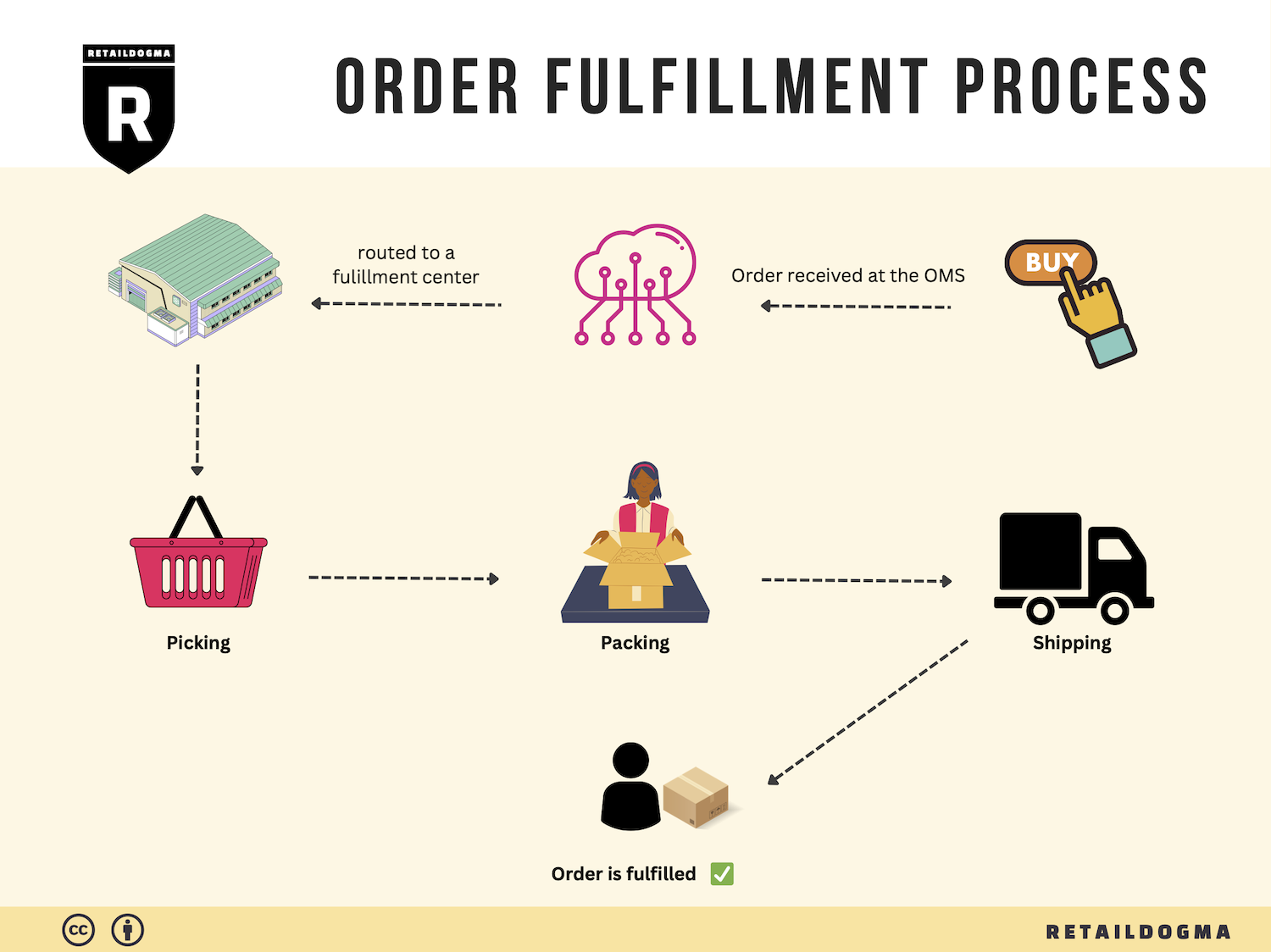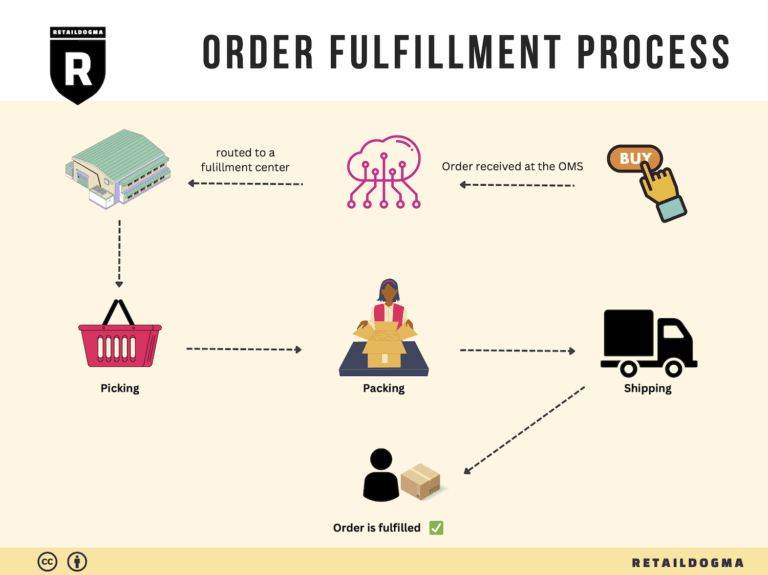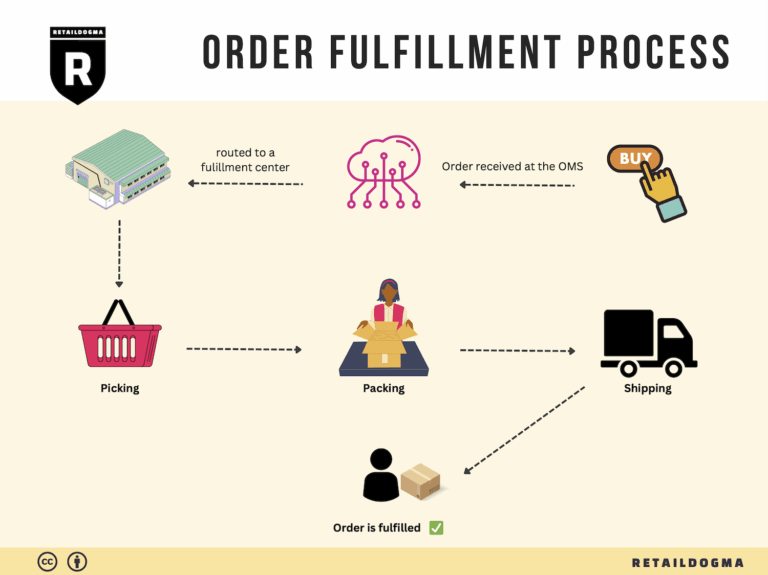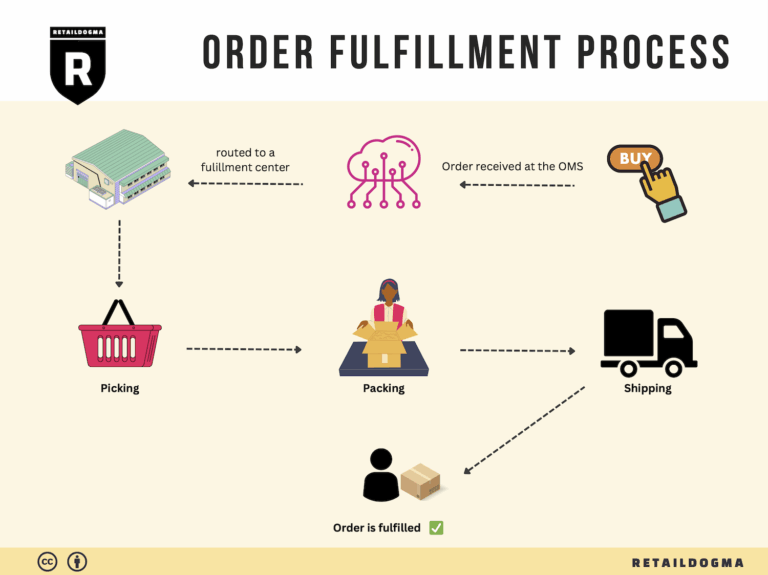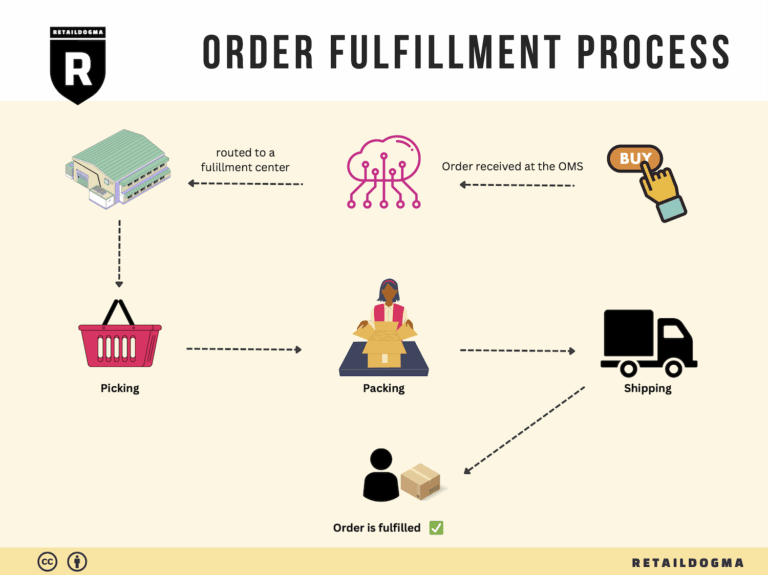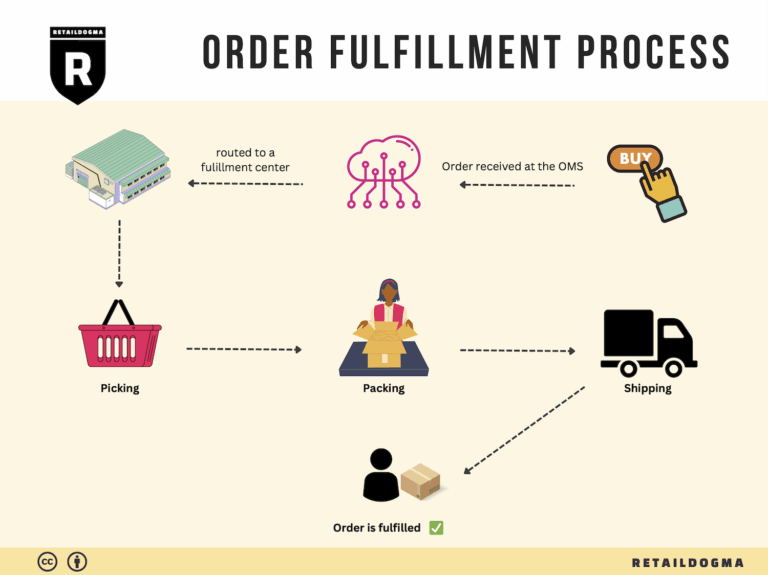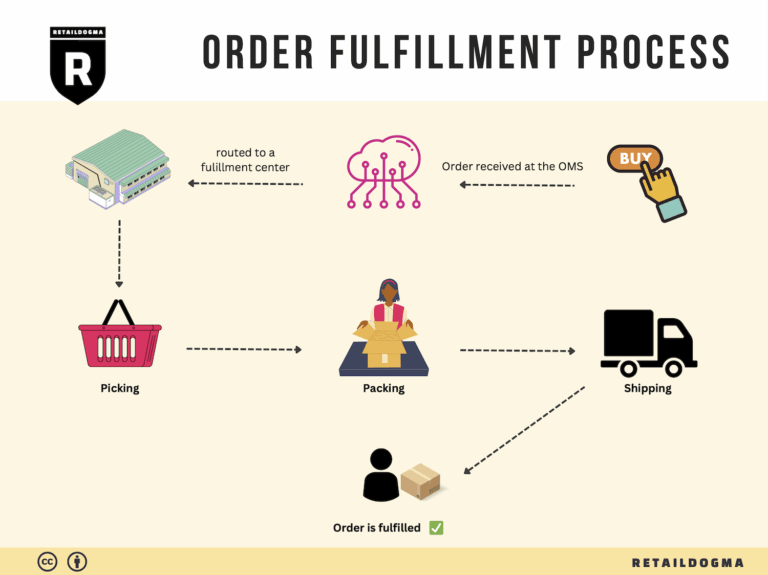What Is A Fulfillment Center? A Complete Guide (2025)
What is E-commerce Fulfillment? An Introduction for Growing Businesses
Understanding E-commerce Fulfillment: A Practical Guide for Growing Businesses
As an e-commerce business owner, you may find yourself grappling with the overwhelming task of packing and shipping orders. The excitement of growing sales can quickly turn into stress when faced with logistics challenges. Efficient order fulfillment is crucial for maintaining customer satisfaction and ensuring timely deliveries. In simple terms, fulfillment refers to the entire process of getting a product from your inventory into the hands of your customer. This encompasses everything from storage and packing to shipping and handling returns.
In this guide, we will explore the various fulfillment models available to e-commerce businesses, including third-party logistics (3PL) and Fulfillment by Amazon (FBA). Each model has its advantages and disadvantages, and understanding these can help you make informed decisions that align with your business goals.
We will also delve into the core services typically involved in e-commerce fulfillment. These services include inventory management, order processing, packaging, shipping, and returns management. Knowing what to expect from potential fulfillment partners can streamline your operations and enhance your customer experience.
Choosing the right fulfillment partner is a critical step in scaling your e-commerce business. We will outline key factors to consider when evaluating partners, such as their technology capabilities, location, scalability, and customer service. A well-chosen partner can not only improve your efficiency but also provide a competitive edge in the market.
Pricing is another important aspect we will cover. Understanding the cost structures associated with different fulfillment options will help you budget effectively and optimize your profit margins. We will break down various pricing models and provide insights on how to assess the true value of a fulfillment service beyond just its price tag.
Ultimately, this guide aims to empower you as a business owner to make smart, informed decisions about your logistics strategy. By understanding e-commerce fulfillment and its various components, you can focus on what you do best—growing your business—while ensuring your customers receive their orders promptly and efficiently.
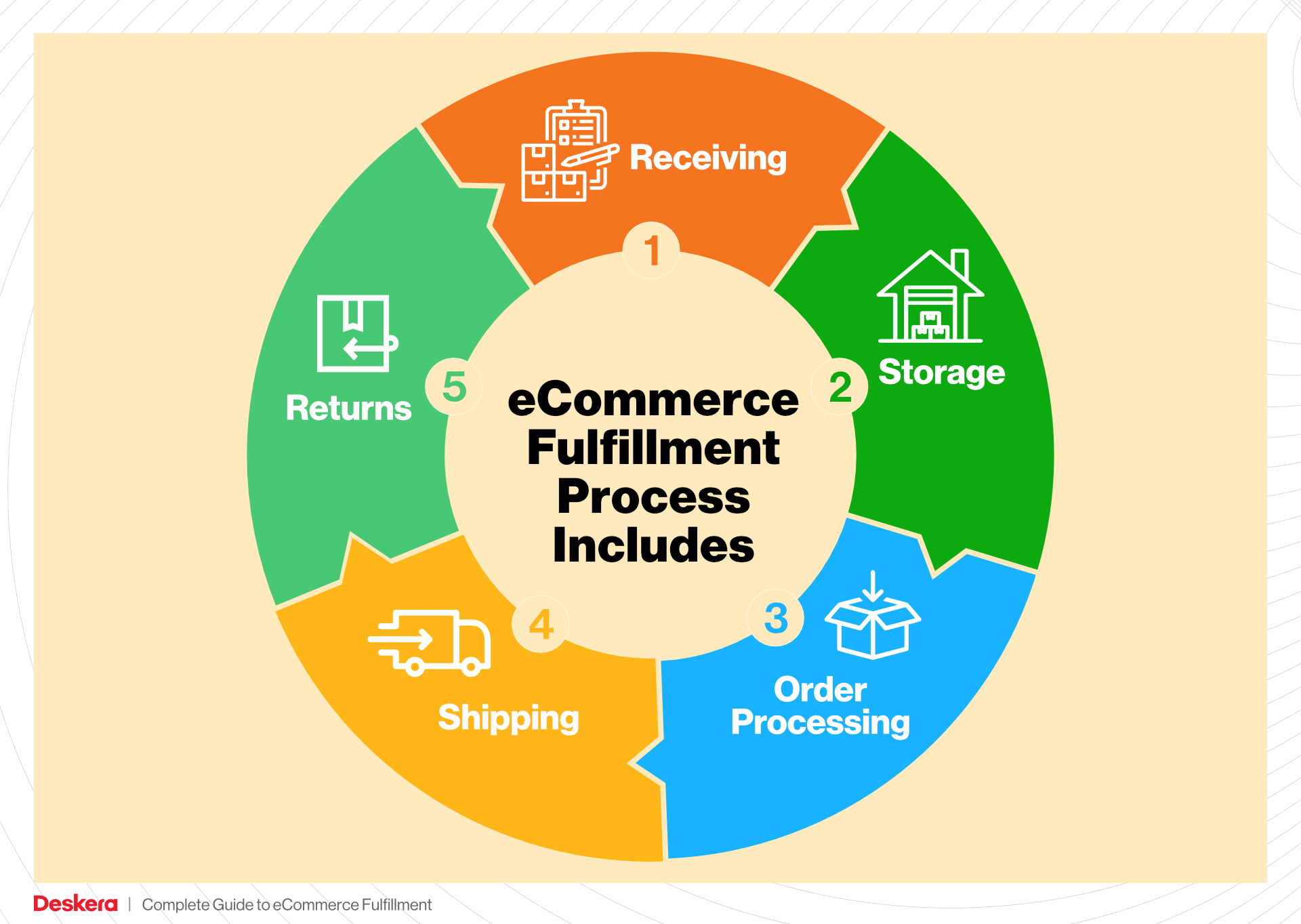
What You’ll Learn In This Guide
- What is E-commerce Fulfillment? An Introduction for Growing Businesses
- The Order Fulfillment Process: From ‘Buy’ Button to Customer’s Door
- Comparing Fulfillment Models: In-House vs. 3PL vs. Dropshipping
- A Deep Dive into Amazon FBA: Pros, Cons, and Who It’s For
- Core Services Offered by Fulfillment Centers
- How to Choose a Fulfillment Partner: A 6-Point Checklist
- Understanding Fulfillment Pricing: A Breakdown of Common Fees
- Frequently Asked Questions (FAQs) about Fulfillment
- Conclusion: Is Outsourcing Fulfillment the Right Move for Your Business?
- Important Disclaimer
The Order Fulfillment Process: From ‘Buy’ Button to Customer’s Door
1. Receiving Inventory
The first step in the order fulfillment process is receiving inventory. This involves the physical acceptance of goods into the fulfillment center, where they will be stored until an order is placed. Upon arrival, shipments are checked against purchase orders to ensure that the correct items and quantities have been delivered.
Importance: This step is crucial for maintaining inventory accuracy and minimizing discrepancies. Any errors at this stage can lead to stockouts or overstocking, both of which can negatively impact sales and customer satisfaction.
Key Term: Stock Keeping Unit (SKU). Each product is assigned a unique SKU, which helps in tracking inventory levels and managing stock efficiently.
2. Warehouse Storage
Once the inventory is received and verified, the next step is to store it in the warehouse. Products are organized systematically, often using a strategy based on product type, size, or demand frequency. Efficient storage solutions may involve shelving, pallets, or bins, depending on the nature of the items.
Importance: Effective warehouse storage optimizes space and improves access to products, which is vital for speeding up the fulfillment process. A well-organized warehouse reduces the time spent locating items, which directly affects order processing times.
Key Term: Location Code. Each storage area is typically assigned a location code, which helps warehouse staff quickly find items and ensures efficient inventory management.
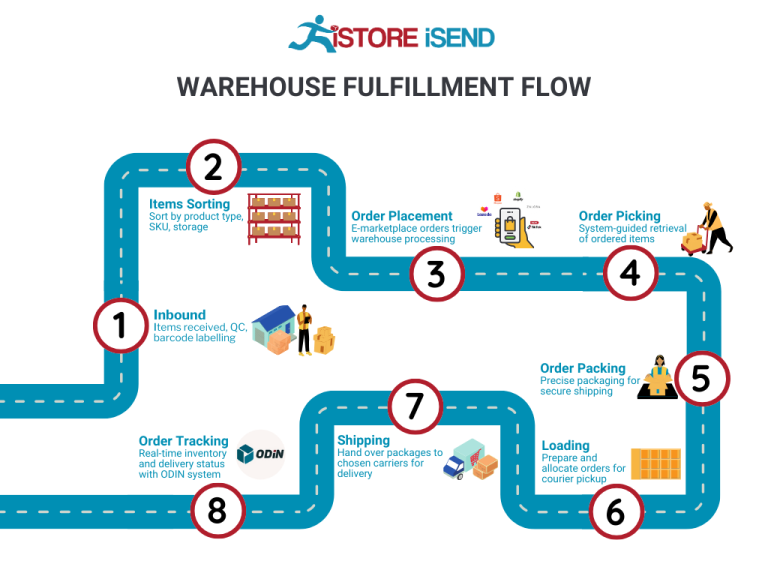
3. Order Picking
When a customer places an order, the next step is order picking. Warehouse staff receive pick lists that detail the items and quantities needed for each order. They then traverse the warehouse to collect the items, ensuring they are selected accurately and efficiently.
Importance: This stage is critical as it directly impacts order accuracy and customer satisfaction. Mistakes in picking can lead to incorrect shipments, resulting in returns and a poor customer experience.
Key Term: Pick Lists. These lists guide warehouse workers through the picking process, indicating where to find each item based on the location codes established during storage.
4. Order Packing
After the items have been picked, they are moved to the packing station where they are prepared for shipment. This includes verifying the items against the order, packing them securely in appropriate boxes, and labeling them for delivery. Packing materials such as bubble wrap, packing peanuts, or branded boxes may be used to ensure items arrive safely.
Importance: Proper packing is essential to protect products during transit and to ensure that they arrive in excellent condition. Additionally, effective branding at this stage can enhance the customer experience and encourage repeat business.
Key Term: Packing Slip. This document accompanies the order and includes details about the items shipped, serving as a receipt for the customer and a reference for returns.
5. Shipping & Delivery
The final step in the fulfillment process is shipping and delivery. Once the order is packed, it is handed over to a carrier for transportation to the customer. This may involve choosing the best shipping method based on cost, speed, and destination. Tracking information is often provided to customers, allowing them to monitor their shipment.
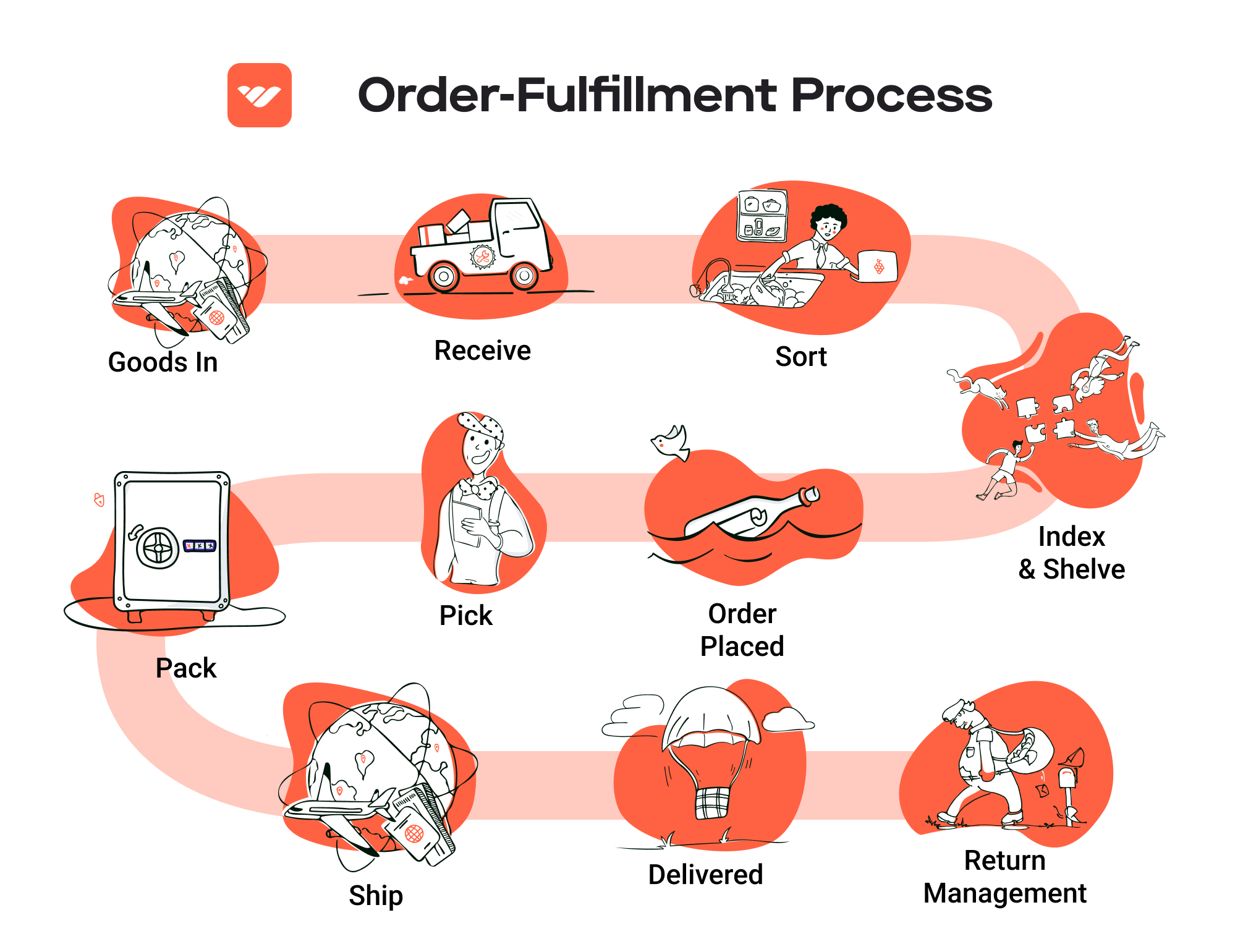
Importance: Timely delivery is a key factor in customer satisfaction. Delays in shipping can lead to frustration and lost sales. Therefore, establishing reliable partnerships with carriers and utilizing efficient shipping methods is paramount for e-commerce success.
Key Term: Last-Mile Delivery. This term refers to the final step of the shipping process, where the package is delivered from a transportation hub to the final customer’s door, which is often the most complex and costly part of the delivery process.
By understanding and optimizing each of these steps in the order fulfillment process, e-commerce businesses can enhance operational efficiency, reduce costs, and ultimately improve customer satisfaction.
Comparing Fulfillment Models: In-House vs. 3PL vs. Dropshipping
Fulfillment Model Comparison
| Model | Who Handles Inventory | Best For (Business Stage) | Key Advantage | Key Disadvantage |
|---|---|---|---|---|
| In-House Fulfillment | The business itself | Established businesses with stable sales | Full control over inventory and processes | High overhead costs and labor management |
| Third-Party Logistics (3PL) | An external logistics provider | Growing businesses looking to scale | Cost-effective and scalable solutions | Less control over fulfillment processes |
| Dropshipping | Supplier or manufacturer | Startups and small businesses with limited capital | Low overhead and minimal risk | Lower profit margins and reliance on suppliers |
In-House Fulfillment
In-house fulfillment refers to the practice where a business manages its own inventory, warehousing, and shipping processes. This model is often adopted by established businesses that have a steady flow of sales and sufficient resources to manage their logistics effectively. The primary advantage of in-house fulfillment is the control it offers over inventory management and the entire shipping process. Businesses can implement their own quality control measures, customize packaging, and ensure that products are shipped according to their standards. This model also allows for faster response times to customer inquiries and changes in demand.
However, the key disadvantage of in-house fulfillment is the high overhead costs associated with maintaining a warehouse, hiring staff, and managing logistics. Businesses must invest in infrastructure, technology, and human resources, which can be a significant burden, particularly for those with fluctuating sales volumes. Additionally, as the business grows, scaling operations can become complex and resource-intensive, leading to potential inefficiencies.
Third-Party Logistics (3PL)
Third-party logistics (3PL) involves outsourcing logistics operations to an external provider that specializes in warehousing, inventory management, and distribution. This model is ideal for growing businesses that are looking to scale their operations without the burden of managing logistics internally. By partnering with a 3PL provider, businesses can benefit from cost-effective and scalable solutions, allowing them to focus on core competencies such as marketing and product development.
One of the primary advantages of utilizing a 3PL is the access to advanced technology and logistics expertise that these providers offer. They often have established networks and systems in place, enabling faster shipping times and improved order accuracy. However, the trade-off is a loss of control over the fulfillment process. Businesses may face challenges in ensuring quality standards are met, as they rely on the 3PL’s processes and practices. Additionally, any issues in the supply chain can directly impact customer satisfaction, making it crucial for businesses to choose reputable 3PL partners.
Dropshipping
Dropshipping is a fulfillment model where the retailer does not keep products in stock. Instead, when a retailer sells a product, it purchases the item from a third-party supplier, who then ships it directly to the customer. This model is particularly attractive for startups and small businesses with limited capital, as it eliminates the need for inventory investment and reduces overhead costs.
The key advantage of dropshipping is its low-risk nature. Retailers can offer a wide range of products without the financial burden of maintaining inventory. This flexibility allows businesses to test new products and markets without significant upfront costs. However, dropshipping comes with its own set of challenges. The primary disadvantage is the lower profit margins, as retailers must often compete with suppliers who sell directly to consumers. Additionally, the reliance on suppliers for inventory management and shipping can lead to issues such as stockouts, shipping delays, and quality control problems, all of which can negatively impact customer satisfaction.
Conclusion
Choosing the right fulfillment model depends on various factors, including business size, sales volume, and operational capabilities. In-house fulfillment provides control but can be costly and complex to manage. Third-party logistics offer scalability and expertise but at the cost of some control over the fulfillment process. Dropshipping presents a low-risk entry point for new businesses, although it may lead to lower profit margins and potential quality concerns. Understanding the strengths and weaknesses of each model is essential for e-commerce business owners, operations managers, and entrepreneurs to make informed decisions that align with their growth strategies.
A Deep Dive into Amazon FBA: Pros, Cons, and Who It’s For
Understanding Fulfillment by Amazon (FBA)
Fulfillment by Amazon (FBA) is a service provided by Amazon that allows sellers to store their products in Amazon’s fulfillment centers. Amazon takes care of storage, packaging, shipping, and customer service on behalf of sellers. This service enables e-commerce businesses to leverage Amazon’s extensive logistics network and customer base to scale their operations efficiently.
When a customer orders a product listed through FBA, Amazon handles the entire process—from picking the item from the warehouse to shipping it directly to the customer. Additionally, FBA products are eligible for Amazon Prime, which can significantly enhance visibility and sales.
How FBA Works
-
Setting Up: To start using FBA, sellers need to create an Amazon Seller Account and enroll in the FBA program. After enrollment, sellers can create FBA listings for their products.
-
Sending Inventory: Sellers prepare their products according to Amazon’s guidelines and ship them to one or more of Amazon’s fulfillment centers. The products are then stored until they are sold.
-
Order Fulfillment: When a customer places an order, Amazon’s system automatically picks the product from the warehouse, packs it, and ships it out. The seller does not have to manage the logistics.
-
Customer Service: Amazon also manages customer inquiries, returns, and refunds for FBA orders, allowing sellers to focus on other aspects of their business.
-
Fees: Sellers are charged fees for storage and fulfillment. These fees vary based on the size and weight of the products.
Pros of Using FBA
Prime Eligibility
One of the most significant advantages of FBA is that it makes products eligible for Amazon Prime, which can lead to higher sales volumes. Prime members are more likely to purchase items that qualify for free two-day shipping, which is a key selling point for many customers.
Enhanced Customer Trust
Products fulfilled by Amazon benefit from the trust associated with Amazon’s brand. Customers feel more secure purchasing FBA items due to Amazon’s reliable shipping and customer service. This trust can lead to increased conversion rates and customer loyalty.
Multi-Channel Fulfillment
FBA offers the flexibility of multi-channel fulfillment. Sellers can use FBA to fulfill orders from other sales channels, such as their own websites or other marketplaces. This centralization of inventory and fulfillment can streamline operations and reduce overhead costs.
Cons of Using FBA
High Fees
While FBA provides numerous benefits, it also comes with costs that can eat into profit margins. Fees include storage fees (monthly and long-term) and fulfillment fees based on the size and weight of the products. Sellers must carefully calculate these costs to ensure profitability.
Strict Inventory Rules
Amazon has stringent inventory management rules that sellers must adhere to. This includes maintaining accurate inventory levels, adhering to specific packaging requirements, and managing returns effectively. Failing to comply can result in additional fees or even account suspension.
Commingling Risks
FBA operates on a commingled inventory model, which means that products from different sellers are stored together. This can lead to issues if a seller’s product is returned or if there are quality control problems. There is a risk that a seller’s inventory could be mixed with lower-quality products, leading to negative reviews and customer dissatisfaction.
Who is FBA Best For?
FBA is particularly well-suited for:
-
Small to Medium-Sized Businesses: Companies that lack the resources to manage logistics can benefit greatly from FBA’s comprehensive fulfillment services.
-
Retail Arbitrage Sellers: Sellers who source products at a lower cost to resell on Amazon can leverage FBA to handle the complexities of storage and shipping.
-
Brands Looking to Scale: Established brands looking to expand their reach can utilize FBA to enhance their distribution without the need for additional warehousing and staff.
-
E-commerce Entrepreneurs: New e-commerce entrepreneurs who want to focus on marketing and product development rather than logistics can find FBA an attractive option.
In summary, Fulfillment by Amazon offers a streamlined approach to e-commerce logistics, enabling sellers to take advantage of Amazon’s vast network. While it has its drawbacks, the benefits—such as increased sales potential and reduced operational burdens—make it a compelling choice for many e-commerce businesses looking to scale efficiently.
Core Services Offered by Fulfillment Centers
Inventory Management & Warehousing
Fulfillment centers, such as Amazon’s Cae1 facility, excel in inventory management and warehousing, providing businesses with an organized and systematic approach to storing products. This service involves the efficient handling of stock levels, ensuring that products are readily available for order fulfillment while minimizing excess inventory.
Benefits for E-commerce Businesses:
-
Real-Time Inventory Tracking: Fulfillment centers utilize advanced inventory management systems that provide real-time data on stock levels. This allows businesses to make informed decisions about restocking and avoid stockouts or overstock situations.
-
Space Optimization: By outsourcing warehousing to a fulfillment center, e-commerce businesses can save on costs associated with maintaining their own storage facilities. Fulfillment centers maximize space through strategic layout and design, ensuring that products are stored in an accessible manner.
-
Scalability: As a business grows, so does its inventory. Fulfillment centers can easily accommodate fluctuations in inventory levels, allowing businesses to scale operations without the need for significant capital investment in additional warehousing.
Pick and Pack Services
Pick and pack services are a crucial component of fulfillment operations. This process involves selecting the right products from inventory and packing them for shipment to customers. Fulfillment centers employ sophisticated picking technologies and efficient packing techniques to streamline this process.
Benefits for E-commerce Businesses:
-
Efficiency and Speed: Fulfillment centers are designed for high throughput, meaning orders can be processed quickly. This speed enhances customer satisfaction through faster delivery times.
-
Accuracy in Fulfillment: With automated systems and trained staff, fulfillment centers minimize the risk of errors in order picking. Accurate fulfillment reduces returns and increases customer trust in the brand.
-
Custom Packing Solutions: Fulfillment centers often provide tailored packing solutions that can include branded packaging, gift wrapping, or special handling for fragile items. This personalized touch can enhance the customer experience and foster brand loyalty.
Kitting and Assembly
Kitting and assembly services involve the grouping of multiple products into a single package or the assembly of components into a finished product. This service is particularly beneficial for businesses that offer bundled products or require pre-assembly before shipping.
Benefits for E-commerce Businesses:
-
Product Bundling Opportunities: Kitting allows businesses to create attractive product bundles that can increase average order value and encourage upselling. By offering curated packages, businesses can enhance their marketing strategies.
-
Streamlined Operations: By outsourcing kitting and assembly to a fulfillment center, businesses can focus on core activities such as marketing and customer engagement. This leads to improved operational efficiency and reduced labor costs.
-
Quality Control: Fulfillment centers often have quality control measures in place during the kitting process. This ensures that products meet the necessary standards before they reach customers, reducing the likelihood of returns due to quality issues.
Returns Management (Reverse Logistics)
Returns management, or reverse logistics, is a critical service provided by fulfillment centers. This process encompasses the handling of returned products, including processing, refurbishing, or recycling items as necessary. Efficient returns management can significantly impact customer satisfaction and retention.
Benefits for E-commerce Businesses:
-
Simplified Return Processes: Fulfillment centers streamline the return process, making it easier for customers to return items. This ease of return can enhance the overall customer experience and encourage repeat purchases.
-
Cost-Effective Handling: By managing returns in-house, businesses can incur additional costs related to processing and restocking. Fulfillment centers are equipped to handle returns efficiently, reducing operational costs for e-commerce businesses.
-
Data Insights: Returns management services often include analytics on return reasons and trends. This data can provide valuable insights into product performance and customer preferences, allowing businesses to make informed decisions about inventory and product offerings.
In summary, utilizing the core services of fulfillment centers like Cae1 can significantly enhance the operational efficiency and scalability of e-commerce businesses. By leveraging their expertise in inventory management, pick and pack services, kitting, and returns management, businesses can focus on growth while ensuring a seamless customer experience.
How to Choose a Fulfillment Partner: A 6-Point Checklist
Location & Warehouse Network
Importance: The geographic location of your fulfillment partner can significantly impact your shipping times and costs. A partner with a strategically placed warehouse network can ensure faster deliveries to your customers, which is crucial for maintaining customer satisfaction and loyalty.
Questions to Ask:
1. Where are your warehouses located, and how does that align with my customer base?
2. Do you have multiple fulfillment centers, and what is the average distance to major shipping zones?
3. Can you accommodate international shipping if my business scales globally?
4. How do you manage inventory across different locations to ensure stock availability?
Technology & Integrations
Importance: A robust technology platform allows for seamless integration with your existing systems (like your e-commerce platform, inventory management, and accounting software). This integration is essential for real-time inventory tracking, order management, and data analytics.
Questions to Ask:
1. What technology solutions do you offer for order management and inventory tracking?
2. Can your system integrate with my existing e-commerce platform and other software?
3. Do you provide real-time reporting and analytics tools?
4. How do you ensure data security and compliance with regulations like GDPR?
Specializations (e.g., cold storage, oversized items)
Importance: Different businesses have unique storage and handling needs. If you sell perishable goods, oversized items, or require specialized handling, you need a fulfillment partner that can cater to those needs effectively.
Questions to Ask:
1. Do you have specific capabilities for handling my product type (e.g., cold storage, fragile items, oversized products)?
2. What processes do you have in place for quality control and damage prevention?
3. Can you provide case studies or examples of similar products you have successfully managed?
4. How do you handle returns for specialized items?
Scalability & Capacity
Importance: As your business grows, your fulfillment partner should be able to scale with you. This includes having the capacity to handle increased order volumes and the flexibility to adapt to your changing needs.
Questions to Ask:
1. What is your current capacity for handling orders, and how do you plan to accommodate growth?
2. How do you manage peak seasons or unexpected surges in demand?
3. Can you provide information on your historical performance during peak times?
4. What are the steps you take to ensure that your operations remain efficient as order volumes increase?
Pricing and Contracts
Importance: Understanding the pricing structure and contract terms is critical to managing your fulfillment costs. Hidden fees or unfavorable terms can erode your profit margins, making it essential to have clear pricing guidelines.
Questions to Ask:
1. What is your pricing structure (e.g., per order, per item, monthly fees)?
2. Are there any additional fees for services like storage, returns, or special handling?
3. What are the terms of the contract, and is there flexibility for renegotiation based on performance?
4. Can you provide a detailed breakdown of expected costs based on my projected order volumes?
Customer Support & Reviews
Importance: Reliable customer support is vital for addressing issues that may arise during the fulfillment process. Additionally, customer reviews provide insights into the partner’s reliability and service quality.
Questions to Ask:
1. What type of customer support do you offer (e.g., dedicated account manager, 24/7 support)?
2. How quickly do you typically respond to inquiries or issues?
3. Can you provide references or testimonials from current or past clients?
4. What is your process for handling disputes or fulfillment errors, and how do you keep clients informed?
By carefully evaluating potential fulfillment partners using this checklist, you can make informed decisions that will support your business’s growth and enhance your customer satisfaction. A solid partnership in logistics can be a game-changer for scaling your e-commerce operations effectively.
Understanding Fulfillment Pricing: A Breakdown of Common Fees
Initial Setup Fees
When partnering with a fulfillment center, the initial setup fee is often the first cost you’ll encounter. This fee typically covers the onboarding process, which includes integrating your e-commerce platform with the fulfillment center’s systems, setting up your inventory, and configuring your account. The amount varies depending on the complexity of your needs and the specific services provided by the fulfillment center.
For example, a basic setup may cost around $200 to $500, while more complex configurations, such as those requiring custom software integration or extensive training, can exceed $1,000. To ensure you have a clear understanding of this fee, inquire about what specific services are included and whether there are any ongoing fees associated with maintaining your account.
Receiving Fees
Receiving fees are charged when your inventory arrives at the fulfillment center. This fee covers the labor and resources necessary for the staff to unload, inspect, and properly store your products. Typically calculated on a per-unit or per-pallet basis, receiving fees can range from $0.10 to $0.50 per unit, depending on the size and weight of the items.
Some fulfillment centers may also charge additional fees for special handling, such as inspecting damaged goods or repacking items. To minimize these costs, ensure that your products are packaged appropriately and that they meet the fulfillment center’s requirements before shipment.
Storage Fees (per pallet/bin)
Storage fees are charged for the space your inventory occupies in the fulfillment center. These fees can be structured in various ways, including per pallet, per bin, or per cubic foot. Typically, storage fees range from $10 to $40 per pallet per month, depending on the location and the demand for storage space.
It’s important to note that some fulfillment centers impose additional fees for long-term storage, often defined as inventory that remains in the warehouse for over six months. To optimize storage costs, regularly assess your inventory turnover rates and implement strategies for reducing excess stock, such as promotions or discounts on slow-moving items.
Pick & Pack Fees (per item/order)
Pick and pack fees are incurred when the fulfillment center picks items from storage and packs them for shipment. This fee is usually charged on a per-item basis, with costs ranging from $0.50 to $3.00 per item, depending on the complexity of the order and the level of service required. For instance, orders that require custom packaging, special inserts, or complex assembly may incur higher fees.
To manage these costs effectively, consider consolidating orders or using standardized packaging for frequently sold items. This not only reduces pick and pack fees but also speeds up the fulfillment process, enhancing customer satisfaction.
Shipping Fees
Shipping fees are among the most variable costs in the fulfillment pricing model. These fees depend on several factors, including the weight and dimensions of the package, the shipping destination, and the shipping method selected (standard, expedited, etc.). Fulfillment centers often negotiate shipping rates with carriers, which can lead to significant savings compared to retail shipping rates.
Shipping fees can range widely, from $5 for small, lightweight packages to $50 or more for larger items or expedited services. To minimize shipping costs, evaluate your shipping options regularly, leverage bulk shipping discounts, and consider using a fulfillment center that offers competitive shipping rates as part of their service package.
Conclusion: Tips for Getting an Accurate Quote
When seeking an accurate quote for fulfillment services, it’s essential to provide detailed information about your business needs. Here are some practical tips:
-
Inventory Details: Share specifics about the types and quantities of products you plan to store and ship. This information helps the fulfillment center provide a more accurate estimate of receiving, storage, and pick & pack fees.
-
Order Volume: Discuss your expected order volume. Higher volumes may qualify you for discounted rates, particularly for pick and pack and shipping fees.
-
Service Requirements: Clarify any additional services you may need, such as custom packaging or special handling. This information will help the fulfillment center account for any extra costs.
-
Contract Terms: Ask about any long-term commitments or penalties for early termination of service. Understanding the terms can help you assess the overall financial impact of the partnership.
-
Compare Quotes: Finally, obtain quotes from multiple fulfillment centers to compare pricing models and services. This will provide a clearer picture of the market rates and help you make an informed decision.
By taking these steps, you can ensure that you receive a detailed and accurate quote that aligns with your business needs and budget, setting the stage for successful scaling in your e-commerce operations.
Frequently Asked Questions (FAQs) about Fulfillment
1. What is the Cae1 Amazon Fulfillment Center?
The Cae1 Amazon Fulfillment Center, located at 4400 12th Street Ext, West Columbia, SC, is a large-scale facility dedicated to storing, packing, and shipping a wide variety of products for Amazon. This center focuses on efficiency and speed, playing a crucial role in Amazon’s logistics network to ensure timely delivery of orders to customers across the region.
2. How does the Cae1 Fulfillment Center operate?
The Cae1 Fulfillment Center operates by receiving inventory from sellers, storing products in a systematic manner, and then picking, packing, and shipping these items directly to customers. Utilizing advanced technology and automation, the center optimizes the fulfillment process to minimize delivery times and enhance accuracy.
3. What’s the difference between a warehouse and a fulfillment center?
While both warehouses and fulfillment centers store products, their purposes differ significantly. A warehouse primarily focuses on storage, inventory management, and bulk shipping, whereas a fulfillment center specializes in processing customer orders, including picking, packing, and shipping items directly to consumers. Fulfillment centers are designed to handle a higher volume of smaller orders and provide faster shipping options.
4. What is a 3PL?
A 3PL, or third-party logistics provider, is a company that offers outsourced logistics services to businesses. This can include warehousing, transportation, inventory management, and order fulfillment. Utilizing a 3PL allows e-commerce businesses to streamline their logistics operations without the need for extensive infrastructure or management.
5. How much do fulfillment services cost?
Fulfillment service costs can vary widely depending on several factors, including the volume of orders, the type of products being stored and shipped, and the specific services required (e.g., packing, labeling, returns management). On average, businesses can expect to pay a combination of storage fees, picking and packing fees, and shipping costs. It’s advisable to obtain quotes from multiple providers to assess competitive pricing.
6. What types of products can be fulfilled at the Cae1 center?
The Cae1 Fulfillment Center can handle a wide range of products, including electronics, apparel, home goods, and more. However, certain restrictions may apply to specific items, such as hazardous materials or perishables. It’s essential for sellers to review Amazon’s policies to ensure compliance with fulfillment requirements.
7. How do I send my products to the Cae1 Fulfillment Center?
To send products to the Cae1 Fulfillment Center, sellers must first create an Amazon seller account and set up their inventory in the Amazon Seller Central portal. From there, they can generate shipping plans, which provide detailed instructions on how to package and label their products for shipment to the fulfillment center.
8. What is the average shipping time from the Cae1 Fulfillment Center?
The average shipping time from the Cae1 Fulfillment Center can vary based on the shipping method selected, destination, and order volume. Typically, standard shipping may take 2-5 business days for domestic orders, while expedited options can reduce delivery times significantly. Amazon’s Prime members often benefit from faster shipping options.
9. Can I track my inventory at the Cae1 Fulfillment Center?
Yes, sellers can track their inventory at the Cae1 Fulfillment Center through the Amazon Seller Central dashboard. This platform provides real-time updates on inventory levels, order statuses, and shipping metrics, allowing sellers to manage their inventory effectively.
10. What should I do if there are issues with my fulfillment orders?
If issues arise with fulfillment orders, such as lost items or delays, sellers should contact Amazon Seller Support for assistance. The support team can help resolve issues related to inventory discrepancies, shipping errors, and customer complaints, ensuring that sellers can maintain a positive customer experience.
Conclusion: Is Outsourcing Fulfillment the Right Move for Your Business?
Evaluating the Benefits of Outsourcing Fulfillment
In today’s competitive e-commerce landscape, outsourcing fulfillment can be a game-changer for businesses aiming to scale effectively. By partnering with a fulfillment service, you can save significant time, allowing you to focus on core business activities like marketing, product development, and customer engagement. This time-saving aspect is crucial, as it enables you to respond swiftly to market demands and customer needs.
Scalability is another compelling reason to consider outsourcing. As your business grows, so do the complexities of managing inventory, shipping, and logistics. A reliable fulfillment partner can effortlessly handle increased order volumes, seasonal spikes, and geographic expansion without the need for significant investments in infrastructure or personnel. This flexibility allows you to adapt quickly to changing market conditions, ensuring that your business remains agile.
Moreover, fulfillment services bring expertise to the table. They are equipped with advanced technology and industry knowledge, ensuring that orders are processed efficiently and accurately. This expertise not only reduces the risk of errors but also enhances customer satisfaction through timely deliveries and improved service quality.
However, the decision to outsource fulfillment should not be taken lightly. Choosing the right partner is critical to your growth strategy. It’s essential to evaluate potential providers based on their capabilities, reliability, and alignment with your business goals.
Call to Action
To determine if outsourcing fulfillment is the right move for your business, consider conducting a thorough audit of your current shipping and logistics processes. Assess your operational bottlenecks, cost inefficiencies, and areas where you could benefit from expert support. This evaluation will provide valuable insights and help you make an informed decision about partnering with a fulfillment service that aligns with your growth objectives. Start today and unlock the potential for streamlined operations and enhanced customer experiences.
Important Disclaimer
⚠️ Important Disclaimer
The information in this guide is for educational purposes. Fulfillment services, pricing, and platform features change frequently. Always conduct your own due diligence and consult with providers directly before making business decisions.
